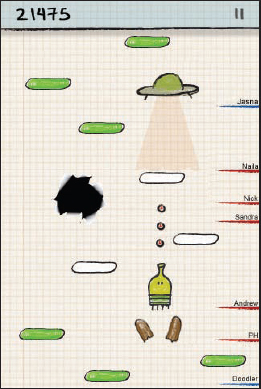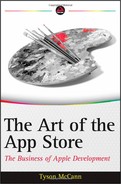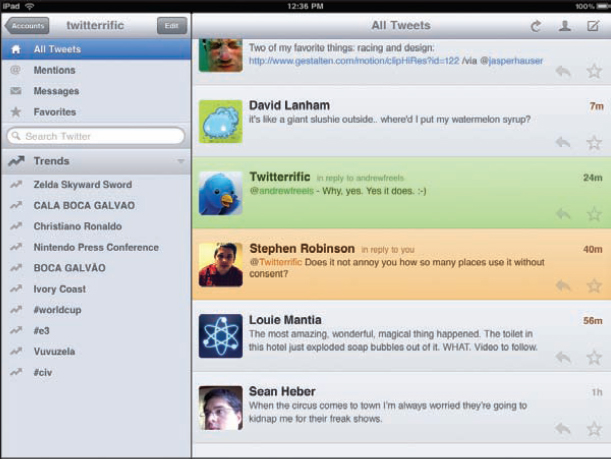CONSIDERING YOUR FUNDAMENTAL COSTS
Unless you have iPhone programmers willing to do the work cheaply, and are coming up with a rather simple utility or business app, developing an exceptional iPhone app is expensive — probably more so than you might think.
In the early days of the App Store, you didn't see huge companies creating apps for hundreds of thousands of dollars, and releasing the apps with the backing of a big marketing budget. You had independent developers cobbling together apps on their own, and occasionally making huge amounts of money.
The ironic thing is that, while apps have become way more expensive to develop over time, the prices of the apps are still at their initial plateau of $;0.99, and occasionally more (albeit sometimes way more for those rare niche apps). There's still the hope for huge profit for any endeavor, and surprise hits will always appear from nowhere to dominate the charts for a time and spawn copies. But you need the right combination of features, usability, and release buzz to drive a success.
So, how much does it cost in 2011 to make an app? According to a Stack Overflow (www.stackoverflow.com) forum answer by Craig Hockenberry (the developer of “Twitteriffic,” shown in Figure 2-6, and available at www.twitteriffic.com), this popular social media app would have cost upward of $250,000 to create, had the owners not done the estimated 1,100 hours of programming on their own. This was at their quoted rate of $150 per hour. As it was, design cost them $34,000, using existing code cost $20,000, and other project management and QA expenses were around $16,000. The bulk of the time, however, was spent on the coding, at an estimated 60 hours per week over 9 weeks.
FIGURE 2-6: “Twitteriffic” would have cost roughly $250,000 to develop
Of course, you can sometimes find programming for much less. Villain actually got a good deal on a foreign team's first job for $25 per hour for its initial game prototype (“Matchlings”). It is safe to assume that many teams are available on Elance, Guru, or oDesk (www.odesk.com) who might do something similar.
Not all apps will have such a high budget, and, as mentioned earlier, it really depends on scope, time, and talent. But to do a sophisticated full-featured app for anything less than $50,000 to $100,000 is wishful thinking. If this is out of your budget, you'll either need people willing to profit-share and work for “free,” raise money, go with cheaper and potentially less-capable developers, or scale down the necessary programming (in other words, scope) and/or art required, because those are typically your two largest expenditures.
Lest the price still seem too daunting, you should be aware of one last thing before learning about the specifics of each cost area. A “simple” game or app with similar features to something else on the market, but enhanced with your own twist, can be made for as little as $4,000 to $10,000 for outsourcing the entire job. However, now that heavy-hitter companies with multiple titles are dominating several App Store categories, it will be more difficult as a rule for an app like that to penetrate the Top 100 or Top 200, which is the sweet spot for revenue generation and maintaining the buzz.
Programming
Unless you have access to or are a great programmer willing to program for little to nothing, chances are you're going to be spending the bulk of your development cost on programming. Prices vary based on experience, location, and name recognition, but you can expect anywhere from $25 per hour at the low end (usually overseas) to $250 per hour at the other end.
With most projects, a contract will typically have several development milestones with built-in contingencies should one party or the other fail to fulfill obligations. For most projects, payment is usually made on evaluation of major milestones. Monthly is a common milestone time period, but depending on how fast the schedule is, it can be faster. This is not to say teams won't have various interim builds to evaluate, but major milestones are spaced farther apart.
![]() Though it is not possible to quote the exact budget of “Archetype,” some general expectations can be shared. For an advanced multiplayer 3D game including using an existing engine (that will need to be licensed), the cost can run in the hundreds of thousands of dollars, most likely in the lower hundreds. This is if you outsource to an external team. For in-house development, it's possible to do it for less, so some thought might be put into whether you should/could hire contracted permanent employees in this case.
Though it is not possible to quote the exact budget of “Archetype,” some general expectations can be shared. For an advanced multiplayer 3D game including using an existing engine (that will need to be licensed), the cost can run in the hundreds of thousands of dollars, most likely in the lower hundreds. This is if you outsource to an external team. For in-house development, it's possible to do it for less, so some thought might be put into whether you should/could hire contracted permanent employees in this case.
Factoring in UI/UX for Game/App Design
If you want to help keep the big costs of programming down (and why wouldn't you?), you're likely going to want to hire a good game/user experience (UX) designer to put together a functional document — especially for business apps that depend mostly on functionality and can't rely on heavy graphics and visual effects to pick up the slack. Any design talent should be familiar with good UI and current iPhone standards in terms of UX, as well as how to design for capacitive touch options like gesturing.
Not unlike programming, design talent typically charges by scope and detail required. Therefore, for a small one-off document for a simple app, you might be able to hire a capable designer for as little as $1,000 to $2,000. But with experience and a good portfolio, it can end up being much more, even in the tens of thousands of dollars for a dedicated designer on a bigger-budget contract.
For any game that requires time to make levels (such as a role-playing game, or anything in 3D), the cost for level design can be up to $5,000 and onward for the project, again dependent on scope.
So, what should you ask for in a designer? You'll typically want these deliverables:
- Initial collaboration on design to get the scope and vision
- Optional but good-to-have items (that is, some competitive research on similar apps to ensure that you're not overlooking features or planning on unneeded ones)
- Initial rough draft of the design document for approval, minus some specifics pending approval
- Final milestone version of the document with all the specifics
- Sometimes (such as for a complex app), gameplay/UX follow-up with the team on early build(s) to ensure that the design is functional and the intent is being achieved
Factoring in Art Design
Like the other necessities, what you spend on art varies widely with scope and talent. As mentioned earlier in this chapter, you could potentially need up to three different types of artists for various tasks, and anything from next to zero total art required (but always a good App Store icon!) to mountains of it.
Art is usually not optional, and the style you choose can sometimes make or break your game/app. This is why competitive research is handy up front to help define current standards in your niche (if one exists), and to help you differentiate.
Once you have the style you're aiming for, get the quotes. For something like a triple-A 3D app, you could spend upward of $50,000 or more for the total art package (not including CGI animation). This would include 3D modeling and textures for exporting into a 3D game, concept art, as well as UI, 3D particle effects, and other in-game art. At the other end of the spectrum, for something similar to the popular vertical scrolling action game “Doodle Jump” (shown in Figure 2-7), assuming it was professionally done and not for free by the programmer, it might be had for as little as $3,000 to $5,000, depending on scope.

FIGURE 2-7: The simple style and hand-drawn art of “Doodle Jump” keeps art costs lower

